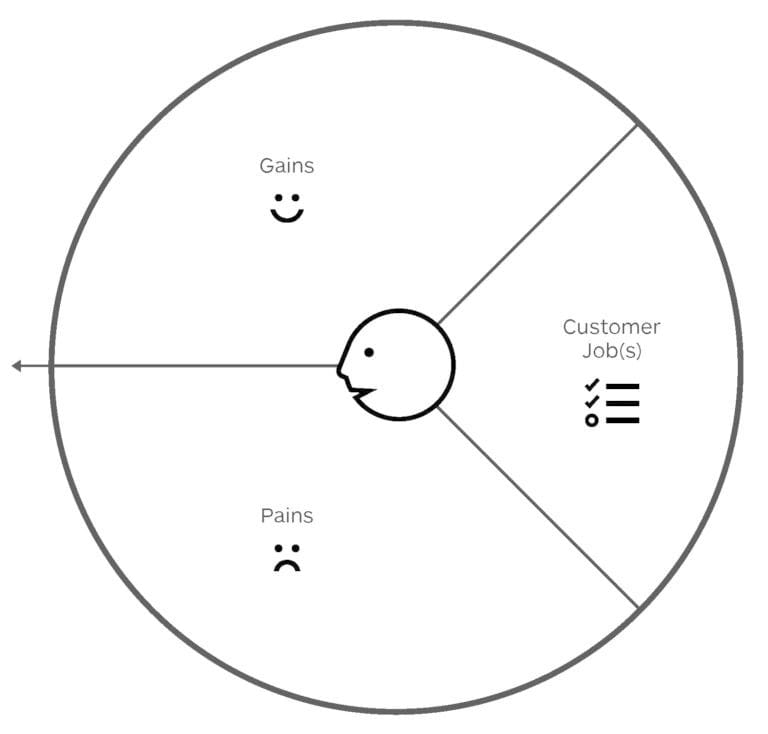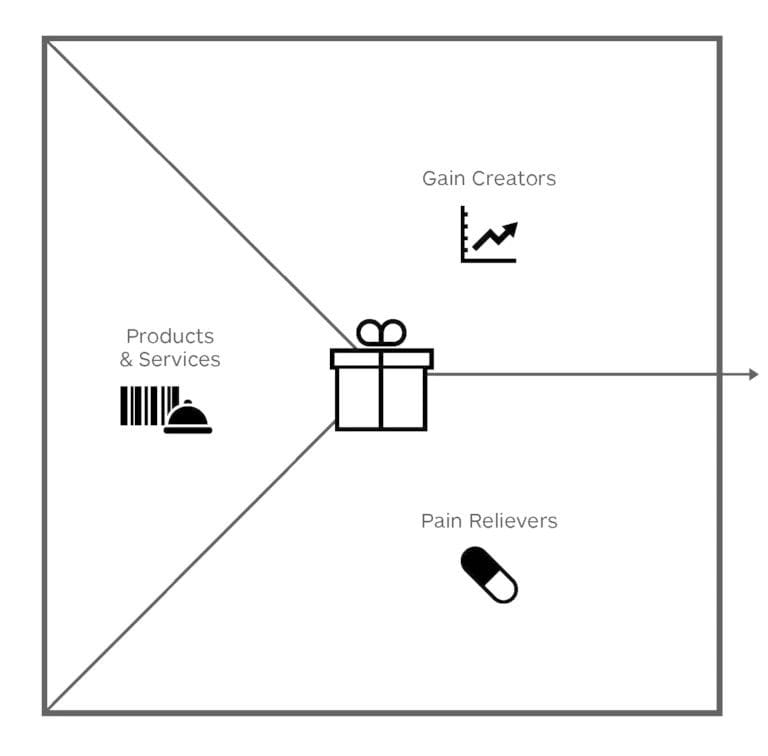To be in business, you must offer value to prospective customers. By making your value proposition explicit, you make it testable. If you can test it, you can improve it. The Value Proposition Canvas is a useful tool for surfacing the assumptions upon which we base key elements of our business strategy.
Take the time to complete all the tasks described below. You’ll end up with a solid first draft of your Value Proposition Canvas, which you can iterate, refine, and improve over time.
Because the world evolves, your value proposition should, too. In other words, it’s a continuing conversation, not a one-and-done affair.
The Value Proposition Canvas consists of a Customer Profile (on the right) and a Value Map (on the left). There is the potential for value creation when there is a fit between the two. The preceding video does a nice job of explaining how the canvas works. To go deeper, we recommend the book, Value Proposition Design.
The concept underpinning the Value Proposition Canvas is straightforward: the potential for value creation exists when your products and services address your prospective customers’ pains and gains. Nothing revolutionary there. The usefulness of the model derives from how it helps us visualize, communicate, and discuss the fit between what we have to offer and what customers want and need the most.
Start with the Customer Profile
Customers are the final arbiter of value, so let’s start with them. As we’ll see in Marketing Physics, value is personal and contextual. Consequently, a value proposition only makes sense relative to a targeted segment. If you serve multiple markets, you’re likely to have several value propositions. (If you haven’t done so already, you can take a deep dive into understanding customers using The Empathy Map Canvas.)
Take five (5) minutes and write down the characteristics of your targeted customer. Be as specific as possible within that timeframe. What long-buried assumptions have you made about who they are?
The customer profile section of the canvas prompts us to list the jobs customers want to get done in their lives. It also asks us to enumerate the outcomes customers desire (gains) and wish to avoid (pains).
The customer profile prompts us to make explicit our understanding of customer jobs, desired gains, and undesired pains.
Customer Jobs
Customer jobs are tasks to perform, problems to solve, and needs to satisfy. They can be functional (“mow the lawn”), social (“achieve status”), or personal (“attain peace of mind”). Jobs can be more or less significant to a customer—don’t fall into the trap of thinking that functional jobs are necessarily the most important.
Grab a pad of Post-it notes. Take five (5) minutes and write down as many relevant customer jobs you can think of. Don’t worry about evaluating them at this point.
Pains
Pains are outcomes, risks, or obstacles to be avoided while doing a job. Pain can be intense or moderate. The reduction of pain represents potential value.
The direct response television (“DRTV”) advertising industry has mastered the art of making customer pain explicit:
You don’t have to sell gimmicky products to learn from DRTV advertisers about how to make customer pain explicit.
You probably aren’t selling your products and services via DRTV advertising. Nevertheless, how DRTV marketers identify customer pain is worthy of attention.
Set your timer for another five (5) minutes. What negative outcomes do your customers wish to avoid when doing their jobs? What obstacles are in their way? Don’t limit your list to those pains your existing product and services are designed to address.
Rank Jobs, Pains, and Gains
It’s not enough to offer value. One must often offer dramatically superior value in order to overcome the inertia of the status quo. Consequently, it’s important to highlight the essential gains or the extreme pains associated with important customer jobs.
Take another five (5) minutes to rank the customer jobs you identified on a spectrum from insignificant to important. Repeat for the pains they wish to avoid (from moderate to extreme) and the gains they seek (from nice-to-have to essential).
Create Your Value Map
Now it’s time to take a systematic look at the goods and services you offer using the left side of The Value Proposition Canvas—the Value Map.
Use the Value Map to link your products and services with customers’ pains and gains.
Grab your sticky notes and write the name of each of your products and services down on a separate note. Once you’ve created a complete set, sort them into two groups: Pain Relievers and Gain Creators. Start with the Pain Relievers. Finally, rank your products and services by the degree to which they address extreme pains or essential gains.
Evaluate Problem-Solution Fit
Your targeted customers stand to benefit from your products and services to the extent the latter addresses essential gains and/or extreme pains. As we’ll see in the Marketing Physics topic, claiming more than a couple of benefits may backfire. To be compelling, your value proposition must be focused, overt, be substantiated by real reason to believe, and must be dramatically different than alternatives. Anything less results in a “Meh.”
Toward Business Model Fit
Articulating a powerful value proposition is necessary but insufficient. It represents a problem-solution fit:
- Problem-Solution Fit—it looks good on paper.
- Product-Market Fit—customers actually buy it.
- Business Model Fit—you can deliver value profitably.
In other words, a value proposition is a hypothesis. It requires market testing. However, a successful product or service doesn’t automatically translate to a successful, sustainable business. That’s where the Business Model Canvas comes into play. It will help you sketch how you intend to deliver value to your customers in a sufficiently profitable manner.
Repeat the Cycle
Your customers’ jobs evolve. Consequently, so do their desired gains and undesired pains. Furthermore, the relative value of alternatives changes—and frequently goes up—over time. Consequently, value proposition design is a recurring project. Standing still in a changing world is a sure-fire recipe for defeat.
Key Ideas
- To be in business, you must offer value to prospective customers. By making your value proposition explicit, you make it testable. If you can test it, you can improve it.
- The Value Proposition Canvas is a useful tool for surfacing the assumptions upon which we base key elements of our business strategy.
- The customer profile section of the canvas prompts us to list the jobs customers want to get done in their lives. It also asks us to enumerate the outcomes customers desire (gains) and wish to avoid (pains).
- Use the value map section of the canvas to link your products and services with customers’ most intensely felt pains and gains.
- Your customers’ jobs, desired gains, and undesired pains evolve. Consequently, value proposition design is a recurring project.





